My new home garden has more issues, and more crops doing well. I have super greens, beets and carrots. The bok choy was amazing early in the season and snow peas are awesome. Popcorn, peppers and eggplants are coming along well. Basil is good, with only a bit of slug damage. I am spreading Sluggo and hope they will go away. The not so good are my broccoli, tomatoes and summer squash.
The broccoli problem is easy to figure out: caterpillars. I have both cabbage worms (from the white cabbage butterfly) and cross-striped cabbage worms. They showed up just as I was harvesting my early bok choy, so that crop had no worm damage. They are very hungry critters and have made a mess of my broccoli plants and are in the heads too. They are also eating my second crop of bok choy. I hand picked a few and mostly was hoping they just would go away on their own, rather than spray. But earlier this week I bought a bottle of spinosad (Captain Jack's Deadbug Spray) and gave them a dousing. I was impressed with how well it worked. The worms were all gone when I checked the plants the next day. I have since picked a few heads and they are worm-free. Spinosad is pretty strong spray and should only be used as a last resort. I hope it did not affect any of my beneficial insects.
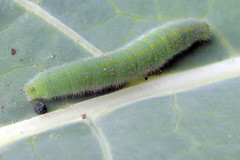
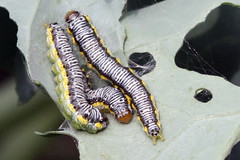

The summer squash problem I am trying to figure out. I have rot at the blossom end of young yellow squashes. I don't know if it is a lack of pollination (I see very few bees there), or blossom end rot due to poor calcium absorption. If its the latter, the problem may be soil pH. The pH is 6.3, calcium 1440 ppm (optimum calcium range 1000-1500 ppm). I read that the optimum pH to avoid blossom end rot should be 6.5-6.8. I will try adding some lime and see if it helps. I am also planting as many flowers around the bed as I can squeeze in hoping to attract more bees in case pollination is an issue. The flowers certainly can't hurt.
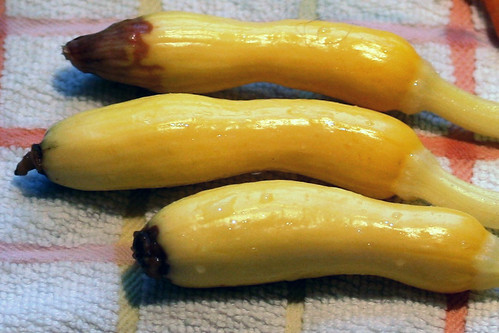
The problem that concerns me most is my tomatoes. They are growing tall and spindly with curled leaves. I really hoped for a great crop of tomatoes this year. I have 24 plants, all different types of heirlooms. They do have a few tomatoes forming on the plants, but the leaf curl is severe and the plants look terrible. I am thinking it is either a tomato virus (maybe transmitted by the white flies I noticed on the plants early in the season), or root damage as from roots going down into the soil below my raised bed. The test of this lower soil showed a pH of 5.9 and very low levels of nutrients P, K, Ca and Mg. I've been fertilizing regularly in hopes this will help. Unfortunately I think its probably a virus and there's nothing I can do about it. :-(
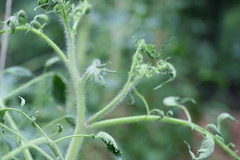
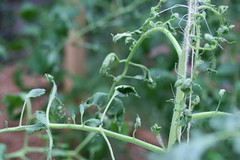
13 comments:
Looks like you are having great success with most of your garden. I find it so frustrating when I put in all the enthusiasm and work only to have my plants destroyed by pests. Do you happen to have paper wasps (not yellow jackets) in your garden? They have been a huge help in controlling the caterpillars on my broccoli, kale, and cabbage. Best of luck. Adam Cortell
I had the same problem with my tomatoes a few years ago. They started out fine, large leaves, blossoms, etc., but then started sending out tiny, convoluted leaves, and little if any blossoms. In addition, the blossoms that did come out either dropped or didn't pollinate. Very bad crops two years in a row.
I first thought it was related to a sungold I had that had horrible spider mites late summer to fall. The other plants I was growing, Italian Heirloom from Seed Savers, eventually got the spider mites too, and they all started growing the tiny misshapen leaves at the same time. I didn't really do anything about it though cause it was already at the end of the growing season. But it continued the next year, from early summer onward, without spider mites.
Last year many of the heirloom seedlings from the nursery I usually buy from were already showing this growth habit in the nursery, though not the hybrids.
The little info I've found online say it's either some kind of virus or herbicide damage. Herbicide damage seems unlikely for me since I'm growing in pots and using bagged top soil & compost, plus the plants can theoretically grow out of it. Mine never have.
Very frustrating. Especially since there's such a dearth of information on what the problem actually is.
The lack of bees is going to be a real problem for us humans. I think the insectacides are killing the bees. We need them for pollination.
I grow all of my tomatoes from seed and two of mine (two different cultivars) look exactly like yours do. They are growing in 5 gallon buckets with good rich clean compost/peat mix. I think it must be a tomato virus transmitted by aphids that I saw on those two plants early in the season. None of my other plants in the buckets have it and they are grown in the same soil mix so I doubt it is caused by low nutrients in your soil. On the bright side mine are setting fruits, albeit not as heavily, but they are not a total loss.
My sympathies! I am finding mildew on my gorgeous crape myrtle which grows in full sun and black fungus on my grapes. Clipped off all the infected grapes and sprayed with copper fungicide but have no idea if that will help.
My tomatoes this year came from the compost pile! I had throw a lot of compost onto the dirt floor of the greenhouse and found many tomato seedlings growing. So I picked the 8 biggest ones and planted them out. All of them turned out to be cherry tomatoes. Drats! I had hoped some would be plum, some would be beefsteaks but every one of them was a cherry. Serves me right for being cheap and lazy!
I think it's a good idea to plant some flowers and herbs, not just for the bees but also other beneficial insects. Many predatory insects need nectar and pollen as adults in order to reproduce and lay their eggs next to or inside prey insects. I let coriander go to seed and flower in my plot, and all sorts of tiny wasps come by. Dill and chives and also good.
For more about what to plant for beneficials, I highly recommend Attracting Beneficial Bugs to your Garden by Jessica Walliser.
A friend told me to plant thyme and sage plants between my brassicas and it would ward off the cabbage moth. It seems to be working! I was very surprised. Never heard of it before.
Anna
Laura,
How do you know it wasn't a virus? Your plants do look just like mine. My legumes are doing great. (Fingers crossed.) My compost is from local yard waste. Who knows what's in there. I wished I could get something organic, but that's all I could find. I don't like buying compost. Look forward to producing my own!
Anna, I will plant sage and thyme between my brassicas next year! Thanks! I love solutions like that. (I'll also cover the plants.)
I have dill blooming all over my community garden plot and everything there is super - almost no pests on the onions, potatoes, and winter squash that I have growing. It reseeds and comes up by itself every year. I think I will try transplanting some of the plants this afternoon.
I am just looking at this as what one has to go through in starting a new garden. Figuring out what pests are around, what crops need to be covered, getting the soil and compost under my control, building up a following of beneficial insects. I am learning how to work with the natural environment of my new space. I don't like using even organic sprays. I should able to work with nature to be spray-free and have healthy crops. Looks like it will take some time to get there.
I noticed that one of my tomatoes doesn't seem to be affected. Its a Brandywine that I bought as a seedling (I grew the rest myself from seed) and planted much later than the rest. Maybe this was after that early white fly infestation and this later plant didn't get infected.
I am pulling out my pea plants this week and thinking maybe I'll buy some tomato seedlings to plant in their place.
"How do you know it wasn't a virus?" It was consistent and repeatable -- it affected all the tomato plants in one bed (with the bad compost), and none of the plants in any of the other beds. Things that were supposed to be affected by the herbicide were, and things that weren't weren't. It's been the same over the years; if I forget and plant something in those beds, there's problems, but fewer problems each year. This year it's been fine.
It's curious that your brandywine is doing well...I've had problems over the years with tomatoes, but never, ever my brandywines. This year I've planted more of them than any because they just seem to be the healthiest no matter the conditions or pests in the area.
Gardening is certainly an adventure--especially getting used to new spaces. But it's a fun adventure.
My Brandywine is getting the same leaf problems. Oh well. Also, my peppers and cucumbers have some issues. I am thinking Laura may be right. I may have soil with an herbicide residue in it. It could be in the loam or the compost I bought, or yard's soil below the beds. I am planning to test by planting tomato seeds in each of the soils. I'd like to know which to blame.
I've heard about "bad compost" recently, too.
Post a Comment